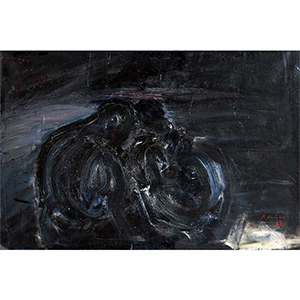July 14 to August 14, 2017
Extended until September 14, 2017
Pierre Omcikus was born in 1926 in Susak (Croatia). He graduated from Academy of Fine Arts in Belgrade in 1947. He moved from Belgrade to Paris in 1952. Since 1960, he has been living simultaneously in Paris and in Vela Luca, on Croatian island Korcula.
Tendency towards classification will reveal through which phases Pierre’s painting has been going, through which paths his conscience of art and life has been breaking through. Cutting off roughly, neglecting transitions, three big blocks will appear immediately: “Realism”, abstraction and new figuration. The boundaries between these blocks are reflected by painter’s biography: in 1952, he came to Paris and joined the most contemporary expression at the time, at the beginning of the 1960s, he began to paint simultaneously in Paris and in the country at the Mediterranean, where he was born. For Omcikus, covering art in modern styles of the time was only a method through which he shows his nature, and not the aim he strives for. That process is usually an illusion which sociological part of modern painter’s inner self uses to understand and receive art. Through the various phases of style, a common denominator of his personality, nature of his individuality will always be recognised.
Still, the language of conveying content is not a meaningless shell. In Omcikus’s case, it always implies courage. Under the circumstances in the country, at the moment when socialistic realism prevailed, one may perceive his leaving of the Academy and leaving with friends to ruined Zadar at the seaside as a feat. It was returning to nature as a teacher, streaming to the truth and eternal themes in painting, decisive attitude against generally accepted stories about work and war. “Aesthetization” instead of naration, alive colourism instead of sweetened uniformity, and rough, playful application of colour, opposite of “polished” artwork -those were the attitudes founded at the time, which were judged as formalistic. In fact, it was a time of birth of a significant painter. Composition full of rhythm, in which elements of nature become system of signs, was brought to Paris.
It also took courage to cope with abstract reasoning. To fly into a cruel life struggle, to master the most subtle laws of lyrical abstraction, to become the most prominent representative of the direction out of an anonymous from the Balkans, losing nothing of his personality and artistic content was certainly a venture of dignity. Actually, looking from the inside of Pierre’s painting, he transferred his precious sensibility and the excellence of his primary works, while bringing his colour, stroke, poetics to the Parisian spectrum of abstract thinking.
At last, the new figuration is a crown of his conflict with conformism. The numerous breads on the shelves, bakeries seen close up, barber shops and barbers seen through windows and shop-windows, create the great compositions of the fights between students and police. In the background of the painting there is a spirit of a critically-minded intellectual, the leftism of its kind which does not escape from everyday life themes. His attitude is being shared both in the country and in Paris.
What is the real denominator of Pierre’s painting? What does he want, and how does he want that?
Rebeliousness -if his attitude can be called that -was ingrained in him from the beginning. It was in his temperament, in his desire not to be a slave of a mere trend, pleasure, comfortable beauty, that he never fell into violent poetization of the painting. Drama was familiar to him as an expression of sprouting feelings, and also as a symbol of the time. It was confronted between light and darkness, streaming to diagonal composition or its rhythms, the confrontation of lightly painted parts of the canvases, to pasture applying of colors, contrasts of black and white, blue and ochre, in almost baroque unity of the painting. Dramatic quality of his works is both robust and pathetic. The son of the land of alfresco painting and epic traditions, he imperceptibly streams to the big and the strong, the wide and the sublime. The battles of his last cycle are the ones of the most adequate expressions of his nature.
Text “Pierre Omcikus’s Painting” by Vojislav Djuric

